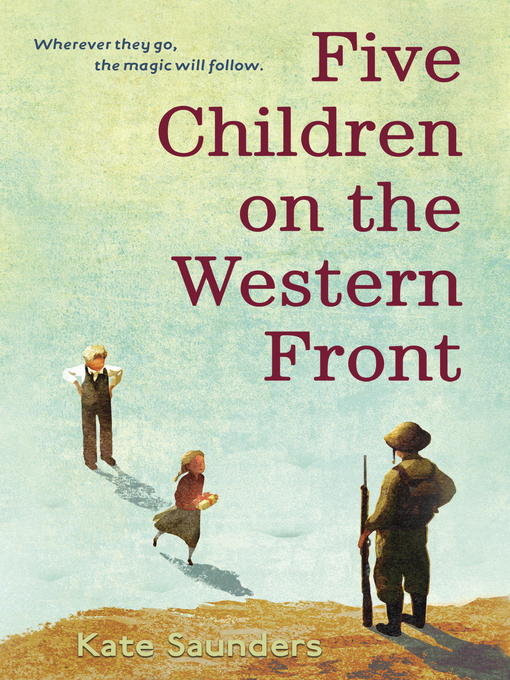
Five Children on the Western Front
فرمت کتاب
ebook
تاریخ انتشار
2016
Lexile Score
800
Reading Level
3-4
ATOS
5.4
Interest Level
4-8(MG)
نویسنده
Kate Saundersشابک
9780553497953
کتاب های مرتبط
- اطلاعات
- نقد و بررسی
- دیدگاه کاربران
نقد و بررسی

vikiis20 - I like this book because sometime the plot makes me nervous, sometimes it makes me wanna cry. There are a lot of different feeling and mood in this book. There are touching part, impressive part, Surprisingly part , also there are some nervous and dangerous part. So when I was reading it, I had many different feeling at the same time, sometimes I could get it, sometimes it's really complicated. But it's still a heartbreaking story.

Starred review from May 23, 2016
Published in 2014 (the centennial of the start of WWI) in England, where it won the Costa Children’s Book Award, Saunders’s moving homage to E. Nesbit’s Five Children and It is an irresistible read for a wide range of readers. In a daring move, Saunders delivers a sequel to the classic fantasy, taking up the characters in 1914 (except for a few instances of time travel), adding a new sibling, and not just reviving the Psammead, but providing a backstory for the “senior sand fairy” that has its own suspenseful movement. Comfortably blending fantasy elements with an English period piece about a close family, Saunders (The Whizz Pop Chocolate Shop) doesn’t shy from the tragedies of WWI, but handles them with a tender sadness, eschewing any hints of sentimentality or melodrama. While readers might be slightly incredulous at the outcome of one horrific event, Saunders casts it in realistic detail. A satisfying epilogue closes the book with the mix of notes that arise from its pages: family, magic, sorrow, and joie de vivre. Ages 10–up.

June 1, 2016
Six characters from a classic work of light British fantasy are resurrected, then two of them are sent to the trenches of World War I.If that doesn't sound like a surefire recipe for success, that's because it isn't. The six characters are E. Nesbit's titular Five Children and It, "It" being the irascible, wish-granting Psammead, discovered in 1903 by Cyril, Anthea, Robert, Jane, and baby "the Lamb." After an ominous prologue, the story begins in 1914 as a sixth child, 9-year-old Edie, and the Lamb, now 11, dig the Psammead up again. He stays with the family throughout the war, as Cyril and Robert go off to fight, Anthea becomes a nurse and falls in love, Jane struggles against convention to become a doctor, and Edie and the Lamb grow into adolescence. Saunders gives the Psammead a convoluted back story and sins to atone for, which mysteriously trigger spectral visits to the front. He is a thoroughly denatured Psammead, cranky but also soggy and sentimental. Saunders does not attempt to emulate Nesbit's direct narrative address, but she does lard the dialogue with "brick"s and "bounder"s to evoke the period. As the Nesbit classic is not much read in the United States these days and World War I has little resonance with U.S. middle-graders, it's hard to say who the stateside audience is. Readers familiar with the classic will probably be dissatisfied with this vision of it; readers unfamiliar with it will be mystified. (Historical fantasy. 8-12)
COPYRIGHT(2016) Kirkus Reviews, ALL RIGHTS RESERVED.

June 1, 2016
Gr 5-8-This continuation of E. Nesbit's "Five Children and It" is set 10 years after the original series ended, during World War I. The Psammead, the magical and ancient sand fairy who took the children on their original adventures, has returned without control of his magical powers, and the youngest children in the family, the Lamb and Edie, try to protect him from discovery. The Psammead's magic returns at intervals, with temporary wish fulfillment and travels through the past to understand why the Psammead lost his powers and how he can redeem himself. Their adventures include visits to both the battlefront and the home front, where the Great War's effects on families and roles for women are very clear. The war affects different members of the family, from the older brothers, who join the British Army, to one of their sisters, who works in a war hospital, to the younger children, who make efforts to help their family and older siblings. The human toll of warfare is clearly and realistically presented, and while some characters find happy resolutions, the family is changed forever. This story stands alone, but it may motivate readers to return to the original books. VERDICT A dramatic, heartrending look at World War I's far-reaching consequences for families and individuals. This book will appeal to both historical fiction and fantasy fans.-Beth L. Meister, Milwaukee Jewish Day School, WI
Copyright 2016 School Library Journal, LLC Used with permission.

July 1, 2016
Grades 5-7 Saunders pulls off a difficult feat here, taking up the narrative begun in E. Nesbit's Five Children and It (1902) and concluded in The Story of the Amulet (1906), and continuing it for an audience in a different century. Although focused primarily on the years 1914 to 1919, the novel often references the adventures the older children had with the Psammead, a sand fairy whose magic includes wishes granted (though often gone awry) and travel through space and time. When 9-year-old Edie and her 11-year-old brother discover the seemingly legendary sand fairy, they look forward to adventures like the ones they've heard about in amusing family stories. But WWI casts a shadow over this close-knit family and even the Psammead himself, whose magic includes glimpses of the war and its effects. Strong portrayals of individual characters bring life and warmth to the story. With the four oldest siblings now actively engaged in the war effort, an entirely happy ending would have been unrealistic, but the novel offers a satisfying conclusion and a rewarding experience.(Reprinted with permission of Booklist, copyright 2016, American Library Association.)

























دیدگاه کاربران